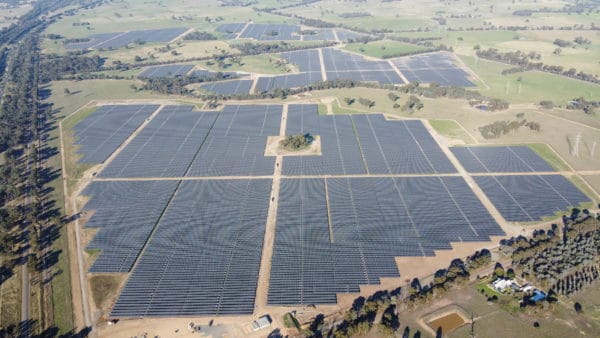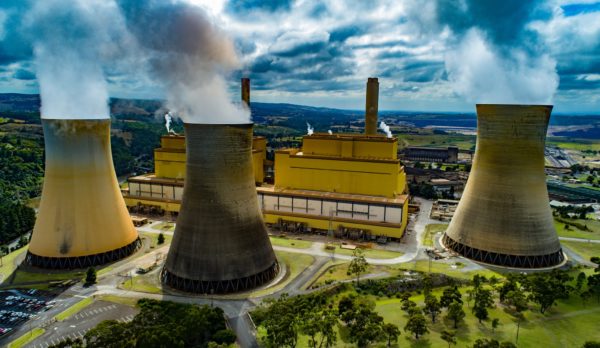The Australian Energy Market Operator’s (AEMO) latest Quarterly Energy Dynamics report shows that new large-scale wind and solar projects connected to the National Electricity Market (NEM) were in part responsible for the setting of several new trading interval records in the last quarter.
AEMO said the average variable renewable energy (VRE) generation increased by 457 MW in Q2 2021, with wind and grid-scale solar contributing 254 MW and 203 MW respectively due to new capacity that has connected to the grid in the past year.
The recent addition of new large-scale wind and solar projects, including the 275 MW Darlington Point Solar Farm in New South Wales and the 200 MW Kiamal Solar Farm in Victoria, saw the average output of grid-scale VRE reach a record 7,368 MW in the June quarter, 483 MW higher than the previous record set in Q1 2021.
Renewables, including grid-scale wind and solar, hydro, biomass and rooftop PV, also achieved a record share of operational demand in the NEM, reaching a record high 57% of total demand between 11am and 11.30am on April 11, up from the previous record of 56% set on October 3, 2020.
The penetration of wind energy also reached a reached high, rising to 5,587 MW at 9pm on May 25, 389 MW higher than the previous record set in Q3 2020, while hydro generation ramped up by 130 MW during the quarter despite dry conditions in some NEM regions.
Grid-scale solar output increased by 203 MW on average, with the largest rise compared to Q2 2020 occurring in New South Wales (NSW) which saw a 139 MW increase. This was driven by a ramping up of recently installed capacity, with the three largest solar farms in the region – Darlington Point, Limondale and Sunraysia solar farms – accounting for 52% of the increase.

Image: WiNRG
Victoria’s output increased by 61 MW on the same period in 2020, driven by continued ramp up of recently installed capacity including the Kiamal and Glenrowan solar farms.
Despite continued ramp up of recently installed capacity, the average Queensland output decreased by 19 MW, mainly due to increased self-curtailment resulting from negative spot prices and high frequency control ancillary service (FCAS) prices.
The figures highlight the importance of AEMO chief Dan Westerman’s recent declaration that the market operator wants to have the conditions in place for 100% of the generating capacity to be supplied from renewables by 2025.
Speaking in Melbourne earlier this month at an event hosted by the Committee for Economic Development of Australia, Westerman upped the operator’s ambitions for renewable penetrations in the grid,
“Right now, we are seeing everyday our control rooms grapple with very high and very low periods of instantaneous renewables penetration,” he said.
“Our job is to operate a safe, secure, reliable and affordable energy system, so we need to be in a position where we can manage 100% instantaneous penetration of renewables.
“This must be our goal, not because of personal ambition or politics or ideology, but because we know this is where we’re headed.”

Image: Energy Australia
AEMO said the continuing growth in VRE output and a reduction in coal-fired generation led to a record decline in emissions, despite increased demand.
The increase in renewable production saw NEM emissions drop to the lowest Q2 total on record at 32.1 million tonnes carbon dioxide equivalent, 1% lower than Q2 2020.
The quarter also saw a dramatic turnaround in wholesale electricity prices following what AEMO said was “an exceptionally low Q1”.
Mainland wholesale electricity prices rebounded strongly after a year in decline, averaging $95/MWh compared to $37/MWh in Q1 2021.
“This represents the highest quarterly average in almost two years, occurring in what is typically a lower-priced quarter,” AEMO said in the report.
Queensland recorded its highest Q2 average on record at $128/MWh, while NSW also increased significantly to $111/MWh, with significant price volatility in both regions, triggered in part by a series of coal-fired generator outages.
While wind and grid-scale solar penetration in the NEM continued to rise, black coal-fired output was comparable to Q2 2020, down 26 MW to 11,164 MW.
Brown coal-fired generation decreased by 182 MW while gas-powered generation was similar to Q2 2020, with increased output during the high-priced peak evening period almost offsetting reductions during other times.
This content is protected by copyright and may not be reused. If you want to cooperate with us and would like to reuse some of our content, please contact: editors@pv-magazine.com.









By submitting this form you agree to pv magazine using your data for the purposes of publishing your comment.
Your personal data will only be disclosed or otherwise transmitted to third parties for the purposes of spam filtering or if this is necessary for technical maintenance of the website. Any other transfer to third parties will not take place unless this is justified on the basis of applicable data protection regulations or if pv magazine is legally obliged to do so.
You may revoke this consent at any time with effect for the future, in which case your personal data will be deleted immediately. Otherwise, your data will be deleted if pv magazine has processed your request or the purpose of data storage is fulfilled.
Further information on data privacy can be found in our Data Protection Policy.